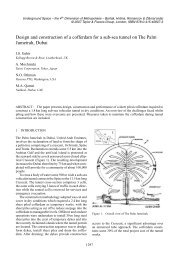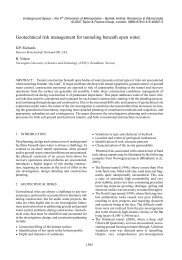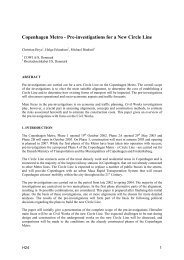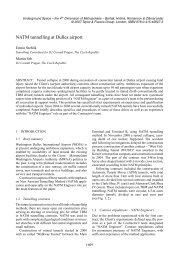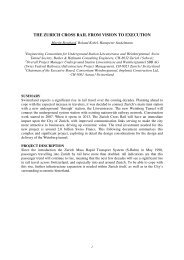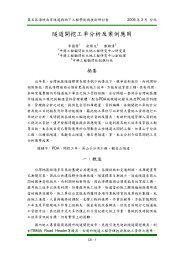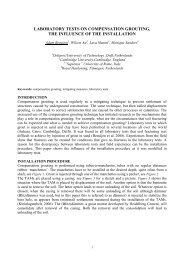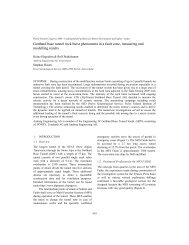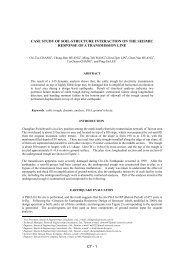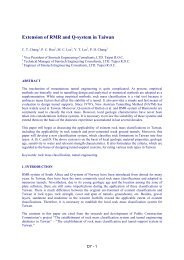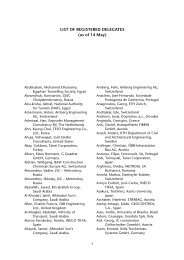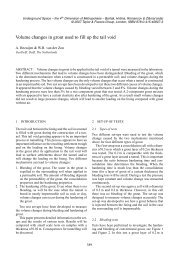the Full Text Article in PDF format
the Full Text Article in PDF format
the Full Text Article in PDF format
You also want an ePaper? Increase the reach of your titles
YUMPU automatically turns print PDFs into web optimized ePapers that Google loves.
Us<strong>in</strong>g equation (1) and (3):<br />
At po<strong>in</strong>t a, u a = u o r o /r a , where r a is <strong>the</strong> distance of po<strong>in</strong>t a to <strong>the</strong> centre of <strong>the</strong> second tunnel.<br />
At po<strong>in</strong>t b, u b = u o r o /r b , where r a is <strong>the</strong> distance of po<strong>in</strong>t a to <strong>the</strong> centre of <strong>the</strong> second tunnel.<br />
The maximum diametrical distortion, δ d is def<strong>in</strong>ed as δ d = u a - u b<br />
The radial distortion is given by:<br />
δ r = δ d /2 (4)<br />
Morgan (1961) showed that <strong>the</strong> bend<strong>in</strong>g moment due to distortion over radius is given by:<br />
M = (3EIδ r )/ r o<br />
2<br />
(5)<br />
Based on equations (4) and (5), <strong>the</strong> additional distortional moment <strong>in</strong> <strong>the</strong> first tunnel l<strong>in</strong><strong>in</strong>g due to <strong>the</strong><br />
second tunnel construction can be calculated. The total bend<strong>in</strong>g moments for structural design of <strong>the</strong><br />
segments are superimposed by add<strong>in</strong>g <strong>the</strong> additional distortional moment to <strong>the</strong> moment due to ground<br />
load<strong>in</strong>g, assum<strong>in</strong>g <strong>the</strong> hoop thrust rema<strong>in</strong>s unchanged.<br />
3. ALLOWABLE ADDITIONAL DISTORTION FOR CONSTRUCTION<br />
The method outl<strong>in</strong>ed <strong>in</strong> Section 2.3 above can be used to make allowance <strong>in</strong> <strong>the</strong> design of <strong>the</strong> tunnel<br />
l<strong>in</strong><strong>in</strong>g to cater for <strong>the</strong> effect of <strong>the</strong> second tunnel construction on <strong>the</strong> first tunnel. However, it is<br />
difficult to monitor such effect dur<strong>in</strong>g construction as <strong>the</strong> method relies on <strong>the</strong> prompt assessment of<br />
<strong>the</strong> volume loss generated by <strong>the</strong> second tunnel construction. This back analysis of <strong>the</strong> volume loss is<br />
typically not readily available at <strong>the</strong> time of tunnel construction. It is thus not practicable to use<br />
volume loss as a controll<strong>in</strong>g parameter dur<strong>in</strong>g construction. In order to overcome this shortcom<strong>in</strong>g, it<br />
is proposed to use <strong>the</strong> conventional convergence monitor<strong>in</strong>g as a means to ensure that <strong>the</strong> additional<br />
distortion of <strong>the</strong> first tunnel due to <strong>the</strong> second tunnel construction is with<strong>in</strong> <strong>the</strong> capacity of <strong>the</strong> l<strong>in</strong><strong>in</strong>g of<br />
<strong>the</strong> first tunnel.<br />
Additional analyses have been carried out <strong>in</strong> <strong>the</strong> design of CCL3 tunnel l<strong>in</strong><strong>in</strong>g to determ<strong>in</strong>e <strong>the</strong><br />
allowable additional diametrical distortion for construction. This allowable diametrical distortion is<br />
not only for <strong>the</strong> effect of second tunnel construction, but also for <strong>the</strong> effects of all o<strong>the</strong>r construction<br />
activities, for example cross passage construction. In <strong>the</strong> analyses, it has been assumed that <strong>the</strong> r<strong>in</strong>g<br />
has a reduced moment of <strong>in</strong>ertia as recommended by Muir Wood (1975). The follow<strong>in</strong>g steps are<br />
taken to determ<strong>in</strong>e <strong>the</strong> allowable diametrical distortion for construction:<br />
• The hoop thrust and moment under <strong>the</strong> ground load<strong>in</strong>g and surcharge are calculated based on <strong>the</strong><br />
method described by Muir Wood (1975) and modified by Curtis (1976);<br />
• The spare moment capacity is taken as <strong>the</strong> difference between <strong>the</strong> ultimate capacity based on <strong>the</strong><br />
re<strong>in</strong>forcement provided and <strong>the</strong> calculated moment due to <strong>the</strong> ground load<strong>in</strong>g and surcharge. Both<br />
ULS and SLS are checked and <strong>the</strong> lesser of <strong>the</strong> two is taken as <strong>the</strong> spare moment capacity that <strong>the</strong><br />
r<strong>in</strong>g has for construction.<br />
• This spare moment capacity is converted <strong>in</strong>to radial distortion with <strong>the</strong> use of Equation (10). This<br />
distortion multiplied by two is thus <strong>the</strong> allowable diametrical distortion for construction.<br />
Assum<strong>in</strong>g <strong>the</strong> allowable diametrical distortion will be fully developed dur<strong>in</strong>g construction, <strong>the</strong> r<strong>in</strong>g is<br />
checked for <strong>the</strong> capacity of 15mm distortion allowed for long term due to adjacent future unknown<br />
F19 6



